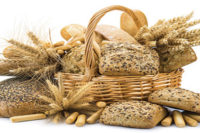In honor of National Heart Health Month in February, this month’s column has a focus on the known cardiovascular benefits associated with grain-based foods, both whole and enriched.
Heart disease is personal for me. I lost both of my grandmothers to heart disease, as well as uncles and aunts. My annual bloodwork certainly encourages me to keep a watchful eye on my nutrition and exercise. And my physician further cautions me that without some serious work on my part, I too could easily find myself a victim of heart disease.
But my story is not unique. According to the Centers for Disease Control and Prevention, one in four deaths in our country is caused by cardiovascular disease—a staggering statistic for a largely preventable epidemic. An estimated 80 percent of all cardiovascular events are preventable and treatable.
The prevalence of cardiovascular disease makes it a topic of high interest and concern among consumers, and remains top-of-mind for health-oriented shoppers making food-purchasing decisions for their families.
The good news is grains can help.
When communicating with consumers, it’s important to understand their interest in cardiovascular health and the role your products play in an overall healthy lifestyle. As always, a healthy, well-balanced diet is key. In fact, the 2017 U.S. News & World Report “Best Diets” list continues to rank balanced diets such as DASH and Mediterranean—both of which include grains and grain-based products—at the top of the list, while criticizing elimination diets that often lead to nutrient deficiencies.
Grains are a top source of fiber, one of the most-important dietary contributions leading to heart health. Yet a whopping 90 percent of Americans fall short of the daily recommended intake (38 grams for men, and 26 grams for women). Grains contribute an estimated 40 percent of all fiber in the American diet, and two-thirds of that fiber comes from enriched grain products such as bread, buns, tortillas, pasta and brown rice.
According to the American Heart Association, being obese puts you at a higher risk for health problems like heart disease. Adding whole grains into a diet has been found to help people maintain healthier body weight and lower the amount of dangerous abdominal fat. In fact, researchers found that adults who get most of their grains from pasta, cooked cereals and rice weigh nearly seven pounds less than others, and on average have a 1-inch-smaller waist circumference than those who don’t regularly eat grains. (Food and Nutrition Sciences, 7(9), 772–781, 2016).
Even though much of the research about grains and heart health focuses on whole grains, there are some marked benefits to enriched grains, as well. Research has linked folic acid found in enriched grains to a healthy heart. The amount of folic acid currently added to enriched grains such as white bread, pasta, cereal and tortillas was found to be optimal for lowering homocysteine levels, an amino acid found in the body that may increase the risk of heart disease. This means enriched grains may also play a role in taking care of your heart. (The American Journal of Clinical Nutrition, 93(1), 11–18, 2011)
So where do grains fit in?
When building a meal, approximately one-fourth of the plate should consist of grains
Whole and enriched grains work together to contribute vital nutrients to the diet, including folic acid, iron, magnesium, vitamin E, B vitamins, calcium and potassium
The 2015–2020 Dietary Guidelines for Americans recommend consuming six servings of grain-based foods per day, with half of these servings consisting of whole grains
With that in mind, this National Heart Health Month, spread the love and pass the grains. For infographics and resources about the heart health benefits of grain-based foods, visit grainfoodsfoundation.org.






